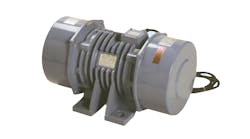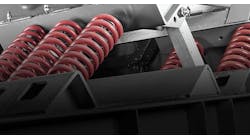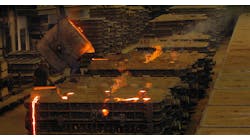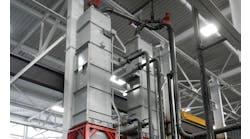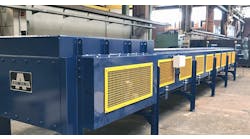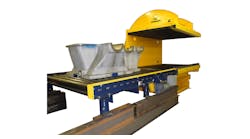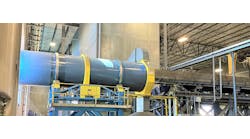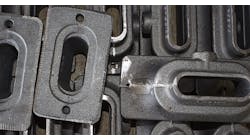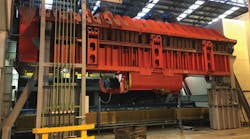Latest from Shakeout
In hundreds of applications around the world, General Kinematics’ Vibra-Drum® sand and casting equipment has transformed high-volume mold and sand handling for foundries. These versatile “Two-Mass” systems execute a shakeout sequence that prevents damage to castings, reduces sand lumps to grain size, and equalizes shakeout sand and casting temperatures, all in a continuous, energy-efficient operation.
Also, Vibra-Drum systems are available for range shakeout capacities (30 to 400 tph), with “superior material motion for efficient sand and casting processing,” according to the developers. For the foundry operators, the system achieves several critical production objectives:
• It performs a gentle shakeout, gradually reducing surface defects that may occur during shakeout. This is accomplished by keeping the casting immersed in a bed of sand, never allowing it to drop, and so eliminating impact between other castings or equipment surfaces;
• It provides a cooling environment for hot castings, using evaporative cooling of moisture from the sand, and the conductive transfer of heat from the casting to the sand. Casting temperatures will be reduced to an average below 200°F (100° C);
• It cleans castings via the vibratory agitation of sand on the outer surface of the castings;
• It reduces sand lumps and produces a homogenous mixture of sand. This is achieved by continuous agitation and drying of the sand, via the heat transfer from the castings.
General Kinematics also describes the Vibra-Drum as “a natural dust containment system.” Its tubular body construction and non-rotating design allows cooling and evaporative air to be directed into the material. This design also is easier to feed and easier to unload. It’s designed with a rolled AR400 liner, which is easy to inspect and replace if necessary. And the drum design does not generate excessive noise, as the cast parts are submerged in sand during processing, so the sound of ‘impact’ is minimized.
Half a century of R&D — The first Vibra-Drums were installed in the 1980s, and the original design has been improved significantly over the last several decades. Those early models were designed as shakeout operations only, smaller units specifically used to break down sand lumps down. Generally, this took six to eight minutes of retention time in the drum body. Once the casting cooling capabilities were recognized, General Kinematics began to engineer larger Vibra-Drum units with 12 to 15 minutes retention time.
Other improvements over from the original 1980s design include:
• Motors are mounted directly to the drum body, so that they remain in alignment according to any movement of the unit;
• Motors and belts are now independent of each other, no longer requiring timing belts or linkages between the drive shafts of the Vibra-Drum; and
• The drum body and exciter construction has advanced according to new, FEA stress analyses of the design, which prevents any high-stress concentration points.
General Kinematics has two significant patents (5,591,074 and 6,237,749) relating to the Vibra-Drum’s “Two-Mass design.” Two-Mass describes a style of vibratory equipment wherein one mass (an exciter) is used to drive a second mass (drum body.) The exciter mass typically contains a motor and is connected to a trough using a combination of springs. Combining the two masses and the springs creates a responsive sub-resonant system that responds to changes in load. General Kinematics’ Two-Mass sub-resonant tuned system means that Vibra-Drums can compensate for variations in load size and weight.
The natural-frequency drums have few moving parts, so maintenance is contained to bearing lubrication and monitoring of motor and drive components. The other important advantage of the Vibra-Drums’ Two-Mass design is the dynamic balancing of the active drive side, so energy is not transmitted into foundations.
Process performance — Installations around the world demonstrate the Vibra-Drum process and its capabilities. One foundry produces electric motors and motor housing components up to frame size 200, very fragile castings that will be chipped with even slight impact. After testing many shakeout system styles, from large rotary drums to flat deck shakeouts, the operators found Vibra-Drum to be the gentlest shakeout on the market.
General Kinematics designed the system so that the primary sand from the mold is blended with a recirculation sand system of up to 100%, so the castings tumble in an active, flowable bed of sand, preventing “casting on casting” damage. With this arrangement the sand-to-metal ratio in the Vibra-Drum is 12:1, and castings float within the bed of sand. This installation also features a water addition system that allows water volume to be added based on the part number. Castings are discharged from the Vibra-Drum at 200-340°F (100-170°C) and move into a vibratory shakeout, then into a GK Spira-Cool® for elevation.
A foundry producing ductile iron truck and off-road components needed a shakeout system as a primary cooler. A large portion of the output is differential/rear end housings. It selected the Vibra-Drum because of its versatility, and because it would not damage castings. There is no water addition system provided in this Vibra-Drum, so the castings discharge out at 300-400° F (150-200° C.) There is a secondary casting cooler located after the Vibra-Drum to reduce the casting temperatures before continuous shot blast.
An Italian gray and ductile iron foundry needed a shakeout to handle very heavy section work, with pour weights up to 700 lb. (320 kg.) Much of its output is gearboxes and cases, and past experience with frequent casting damage in a rotary drum influenced its choice of the Vibra-Drum. In this installation castings are discharged at 200-350°F (100-180°C) and there is a shakeout and sorting table after the Vibra-Drum, which feeds castings directly to a continuous shot-blast operation.
Lastly, a grey and ductile casting foundry supplying cast parts to oil-and-gas industry customers installed a Vibra-Drum to replace a media drum. This customer had recorded damage rates up to 50% of its castings in the rotary drum, requiring it to remove castings prior to entering the drum. With the Vibra-Drum installation this jobbing foundry is able to run all castings through the unit, from heavy pumps that have thick sections to large, rangy parts that cannot withstand twisting or deformation. All of these castings pass through the Vibra-Drum without problem.
While the General Kinematics Vibra-Drum has transformed high-volume mold and sand handling for foundries around the world, the system developers promise to continue to engineer system designs and upgrades that will solve customer problems.

